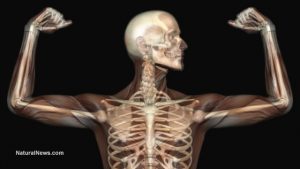
Atrophy – causes, side effects and treatments at NaturalPedia.com
Saturday, January 06, 2018 by Earl Garcia
http://www.naturalpedia.com/atrophy-causes-side-effects-and-treatments-at-naturalpedia-com.html

Spinal muscular atrophy (SMA) is a hereditary condition that triggers the nerve cells in the lower part of the brain and spinal cord to breakdown and die, according to an article published on the Kids Health website. The article explains that SMA can be categorized into four types. Type I SMA or Werdnig-Hoffmann disease is the most severe form of the disease, which manifests from birth up to six months of age.
Most babies show signs of type I SMA by three months, but some may develop the condition before birth. Type II SMA or chronic infantile SMA is known to affect children between six and 18 months old. Type III SMA, also called Kugelberg-Welander disease or juvenile spinal muscular atrophy is the mildest form of the disorder and may start as early as 18 months or as late as adolescence. Furthermore, type IV SMA is known to impact adult patients 35 years and older. This type is found to slowly get worse over time.

Known side effects of atrophy
Atrophy is most commonly associated with general muscle weakness and muscle loss. The disease is known to significantly weaken the arms and legs and cause movement problems, an NHS.uk entry shows. According to the article, SMA may also trigger twitching or shaking muscles and bone and joint problems. Scoliosis is the most common form of skeletal condition caused by the disease. The article adds that SMA may lead to the onset of swallowing and breathing problems in patients.
Body systems harmed by atrophy
Atrophy is primarily detrimental to the muscular system. Likewise, the condition is known to compromise bone and joint health. The disease may also impact the respiratory tract and the body’s digestive profile.
Food items or nutrients that may prevent atrophy
An article posted on the Live Strong website reveals that the nutrient creatinine has the potential in reversing muscle atrophy. According to the entry, creatinine is one of the naturally occurring building blocks of protein and is readily available in meat and fish. The article also touts that using protein powder may be helpful in relieving muscular atrophy. Moreover, the entry suggests that patients take stinging nettle supplements to ease muscle and joint soreness.
Treatments, management plans for atrophy
A Health Line article emphasizes that exercise and dietary changes may help manage the condition. The entry also notes that patients may undergo ultrasound treatment or surgery to correct the condition. According to the article, ultrasound therapy is a noninvasive procedure that makes use of sound waves to facilitate healing. The article adds that surgery may be required for patients suffering from contracture deformity, a condition where the tendons, ligaments, skin or muscles become too tight that makes movement difficult.
Likewise, an article featured on the Medical News Today website touts that the U.S. Food and Drug Administration (FDA) approved the SMA drug Spinraza in December 2016. Furthermore, the article stresses that a wide array of assistive technology – such as ventilators, power wheelchairs and modified computer access – are now being used to effectively manage the disorder in patients.
Where to learn more
- Compound in apple peels found to prevent muscle wasting from aging and illness
- You can’t beat the beet for muscle recovery: Scientists reveal how the superfood heals muscle damage
- Maintaining muscle mass as you age requires consuming protein at least three times throughout the day
- New study finds older adults should pump more iron: Weight training has better results than cardio for weight loss in the over 60 crowd
- How an active lifestyle determines your “structure” for life: Muscle activity determines skeletal health, according to recent research
- You choose your brain health with your diet: Anti-inflammatory diet improves brain health while inflammatory diet accelerates atrophy
Summary
Atrophy causes general muscle weakness, muscle loss and movement issues.
Atrophy triggers the onset of muscle tremors and bone and joint disorders.
Atrophy compromises both the muscular and skeletal systems’ overall health.
Atrophy also affects both the respiratory tract and the digestive profile.
Sources include:
Tagged Under: Tags: Atrophy





